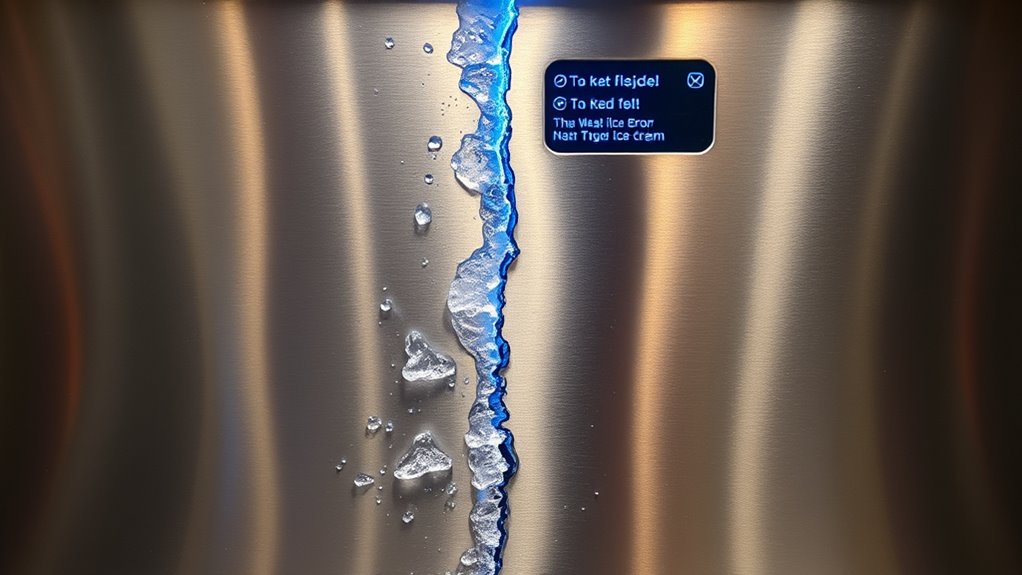If your commercial ice cream machine breaks down, start by checking the power source and circuit breakers to guarantee stable electricity and no overloads. Verify that temperature controls are set correctly and look for error messages. Inspect the condenser and airflow vents for dust or obstructions, and listen for compressor noise. Also, examine or replace filters and components if needed. If you keep these basics in mind, you’ll spot common issues fast and find more ways to troubleshoot effectively.
Key Takeaways
- Check for power supply issues, including circuit overloads or tripped breakers, and reset if necessary.
- Inspect the control panel for error messages or indicators and recalibrate controls if needed.
- Listen for abnormal compressor sounds or verify refrigerant lines are cool to identify cooling problems.
- Ensure condenser fins and vents are clean and free of debris or ice buildup for proper airflow.
- Confirm air filters are clean and replace them regularly to prevent airflow obstruction and maintain system efficiency.
Check the Power Supply and Circuit Breaker
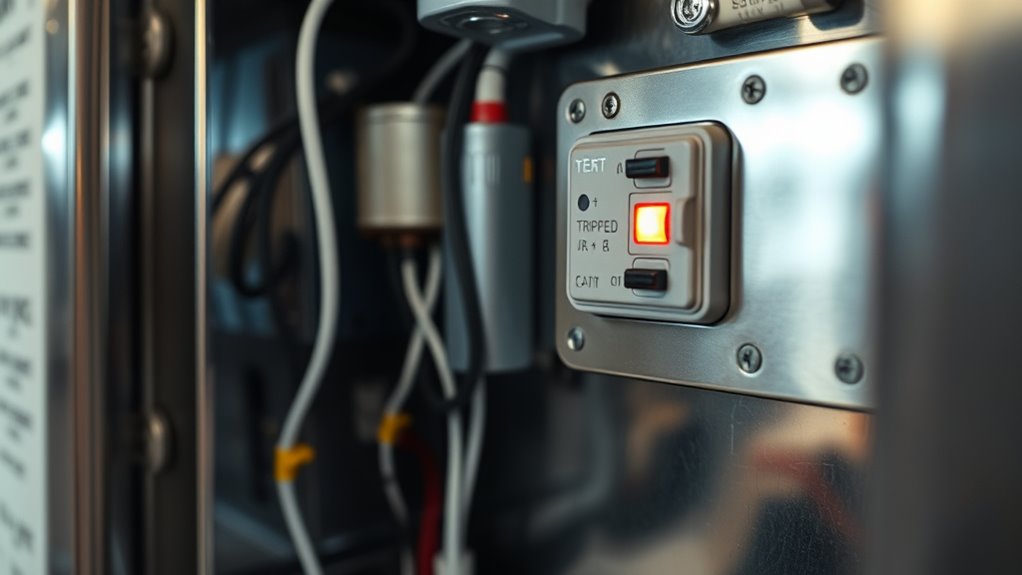
Before troubleshooting your commercial ice cream machine, you should first check the power supply and circuit breaker. A power surge can cause fluctuations that disrupt the machine’s operation, so ensure your power source is stable. Look for any signs of a circuit overload, which happens when too many devices draw power from the same circuit, tripping the breaker. If the breaker has tripped, reset it carefully and avoid overloading the circuit again. Also, verify that the power cord is plugged in securely and that there are no visible damages. Sometimes, a simple power issue is the root cause of the malfunction. Ensuring proper electrical connections and understanding power supply stability can help prevent equipment damage. Additionally, consulting your equipment’s electrical specifications can ensure compatibility and safe operation. Regularly checking circuit breaker status can help maintain ongoing electrical safety and functionality. Being aware of your electrical load capacity can also help prevent future issues with your equipment. Maintaining awareness of the electrical system’s health further reduces the risk of unexpected failures.
Inspect the Temperature Settings and Controls
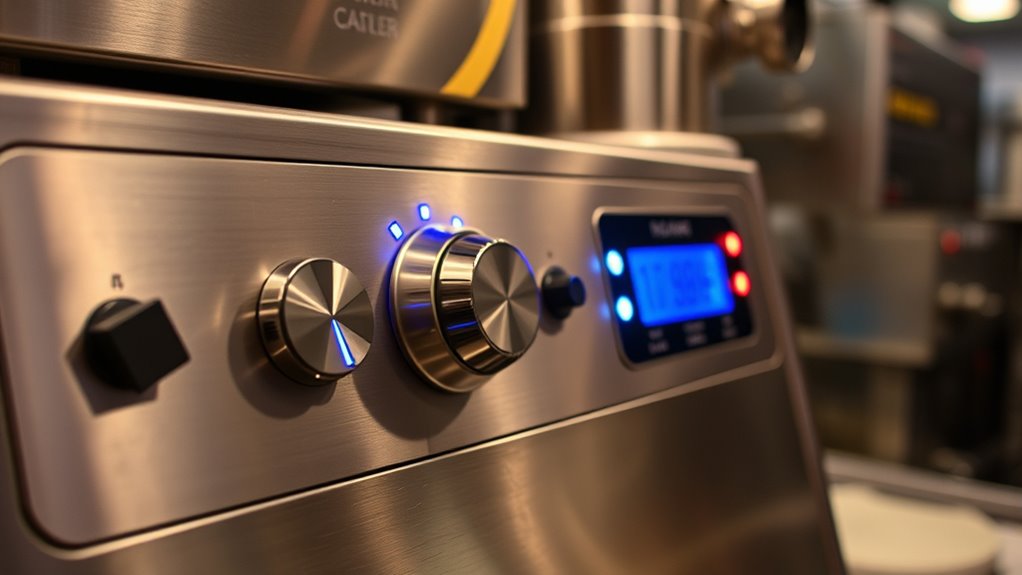
After ensuring your power supply and circuit breaker are in good shape, the next step is to verify the temperature settings and controls. Start by examining the control panel for any error messages or unusual indicators. Confirm the temperature calibration is set correctly according to the manufacturer’s specifications; an incorrect calibration can cause improper freezing or inconsistent texture. Adjust the temperature controls if needed, making sure they’re within the recommended range for ice cream production. Sometimes, a simple reset or recalibration of the control panel can resolve issues caused by user error or minor glitches. Double-check that all buttons and dials are functioning properly, and look for any signs of damage or dirt that might interfere with accurate readings. Properly calibrated temperature controls are essential for ideal machine performance. Incorporating precise calibration techniques can help maintain consistent results and prolong the lifespan of your ice cream machine. Additionally, regularly inspecting the control panel for firmware updates or software glitches can prevent operational errors. Ensuring the control system is functioning correctly is crucial for maintaining optimal machine performance.
Examine the Condenser and Airflow Vents
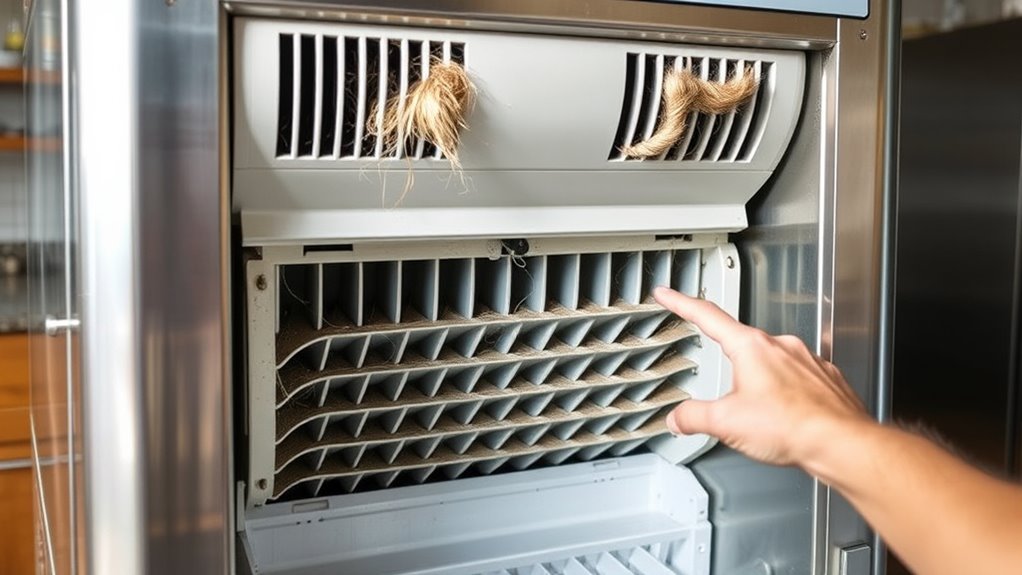
Start by checking the airflow vents for any blockages that could impede airflow. Then, inspect the condenser fins to make sure they’re clean and free of debris. Proper airflow is essential for your machine to operate efficiently and prevent overheating. Additionally, ensuring your condenser is free of keto-friendly ingredients can help maintain optimal performance. Regular maintenance of these components supports the longevity and efficiency of your ice cream machine. Remember to verify headphone compatibility if you plan to use audio alerts or troubleshooting guides during maintenance. Incorporating industry best practices into your routine can further enhance the machine’s reliability and performance. Monitoring industry trends can also help you stay informed about new maintenance techniques and equipment updates.
Check Vent Blockages
Blocked vents can considerably impair your ice cream machine’s cooling performance, so it’s essential to examine both the condenser and airflow vents regularly. Vent blockage causes airflow restriction, preventing proper heat dissipation and risking system overheating. Check for dust, debris, or anything blocking airflow paths. If vents are clogged, clean them carefully to restore airflow. Use the table below to identify common causes and solutions:
| Cause | Effect | Solution |
|---|---|---|
| Dust buildup | Airflow restriction | Clean vents thoroughly |
| Obstructed vents | Reduced cooling efficiency | Clear debris |
| Blocked fans | Overheating | Remove obstructions |
Regular inspection ensures your machine maintains peak performance and prevents breakdowns caused by vent blockage. Additionally, following proper air purifier maintenance dos and don’ts can help keep components clean and functioning effectively. Keeping your machine’s components clean can also prevent performance issues and prolong its lifespan, especially when considering the importance of ventilation systems in cooling efficiency.
Inspect Condenser Fins
Have you examined the condenser fins lately? Dirty or damaged fins can restrict airflow, causing your ice cream machine to overheat or freeze improperly. Check for debris, dust, or ice buildup that blocks ventilation. Confirm there are no refrigerant leaks, as low refrigerant levels impair heat exchange. Also, inspect electrical connections to verify they’re secure; loose or corroded wires can prevent the condenser from functioning correctly. Proper airflow is essential for efficient cooling, so clean fins gently with a brush or compressed air. If you notice refrigerant leaks or faulty electrical connections, address these issues promptly. Fins that are bent or clogged reduce heat dissipation, risking compressor failure. Regularly inspecting and maintaining your condenser fins can prevent costly repairs and keep your ice cream machine running smoothly. Additionally, monitoring heat exchange efficiency can help identify underlying issues early.
Verify the Compressor Functionality

To verify the compressor’s functionality, you should first listen for its operation when the machine is running. A healthy compressor makes a consistent compressor noise—a steady hum or buzz—without clicking or rattling sounds. If you don’t hear any noise, the compressor might not be working properly. Next, check the refrigerant level; low refrigerant can cause the compressor to stop or run inefficiently. Ensure the refrigerant lines are cool to the touch, indicating proper operation. If the compressor isn’t running or sounds abnormal, it could be a sign of electrical issues or mechanical failure. Addressing these signs early helps prevent further damage and keeps your ice cream machine running smoothly. Additionally, inspecting the compressor’s performance and reliability can help determine if tuning or repairs are necessary to maintain optimal function. Regular maintenance checks can also extend the lifespan of your compressor and ensure consistent ice cream quality, with attention to the refrigerant levels playing a crucial role in overall performance. Moreover, understanding the AI discoveries related to machinery and physics can inform more advanced diagnostic techniques for equipment troubleshooting.
Clean or Replace the Air Filter and Other Components
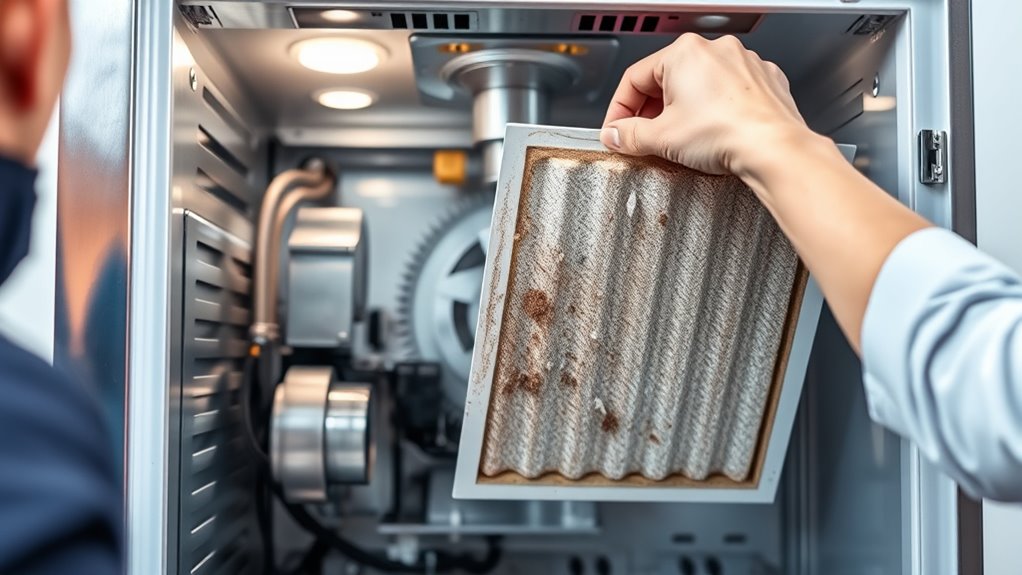
Regularly inspect your air filter to guarantee it’s clean and functioning properly. Replace any worn components promptly to prevent system issues. Also, clean the condenser coils thoroughly to maintain ideal airflow and performance. Incorporating preventive maintenance practices can extend the lifespan of your machine and enhance its efficiency.
Inspect Air Filter Regularly
Since dust and debris can quickly clog the air filter, inspecting it often is essential for maintaining your ice cream machine’s performance. Regular air filter maintenance helps prevent airflow obstruction, which can cause overheating or inefficient operation. Check the filter at least once a month, especially if the machine runs frequently. If you notice dirt, dust, or debris buildup, clean the filter according to the manufacturer’s instructions or replace it if it’s worn out. A clean air filter ensures proper airflow, keeps the compressor cool, and prevents unnecessary strain on the system. Neglecting this step can lead to reduced cooling efficiency and potential breakdowns. Staying vigilant with air filter inspections keeps your machine running smoothly and minimizes costly repairs.
Replace Worn Components Promptly
Promptly replacing worn components, including cleaning or swapping out the air filter, helps keep your ice cream machine running efficiently. Following a proper maintenance schedule ensures you catch issues early and prevents costly breakdowns. Regular component replacement minimizes strain on the machine’s parts, reducing the risk of overheating or mechanical failure. Check the air filter and other key parts frequently, and replace them as needed rather than waiting for problems to arise. Keeping components in good condition extends the lifespan of your equipment and maintains peak performance. Don’t ignore signs of wear—address them quickly to avoid downtime. Staying proactive with maintenance and timely component replacement keeps your ice cream machine operating smoothly and prevents small issues from escalating.
Clean Condenser Coils Thoroughly
To guarantee your ice cream machine operates efficiently, it’s essential to clean the condenser coils thoroughly. Dust, dirt, and debris can block airflow, causing the compressor to overwork and risking refrigerant leaks or condenser coil damage. Here’s what to do:
- Turn off the machine and unplug it for safety.
- Use a brush or coil cleaner to remove dirt and buildup from the coils.
- Inspect the coils for signs of damage or corrosion, which can lead to refrigerant leaks.
Regular cleaning prevents overheating and ensures proper heat exchange. Neglecting this step can result in inefficient cooling and costly repairs. By maintaining clean condenser coils, you keep your machine running smoothly and extend its lifespan.
Review Error Codes or Indicator Lights

Are you noticing blinking lights or unusual error codes on your commercial ice cream machine? These indicators often signal specific issues that can affect your ice cream flavor or suggest your machine needs maintenance. Start by consulting the user manual to identify what each error code or light means. Many machines have diagnostic displays that help you pinpoint problems quickly. Ignoring these signals can lead to inconsistent ice cream quality or further damage. Once you understand the error, you can address it directly—whether that’s adjusting settings, cleaning components, or scheduling professional maintenance. Reviewing and interpreting these codes saves you time and prevents unnecessary repairs, ensuring your machine runs smoothly and your ice cream flavor stays perfect. Always keep error codes in mind during routine maintenance.
Frequently Asked Questions
How Often Should I Perform Routine Maintenance on My Ice Cream Machine?
You should perform routine maintenance on your ice cream machine regularly to keep it running smoothly. Follow a preventative cleaning schedule daily or after each use to prevent buildup, and stick to lubrication schedules as recommended by the manufacturer. Regularly inspecting parts and cleaning ensures peak performance and reduces breakdowns. By maintaining a consistent routine, you’ll extend your machine’s life and avoid unexpected issues during busy periods.
Can I Fix a Broken Ice Cream Machine Myself?
You might think you can fix your ice cream machine yourself, but DIY fixes for common issues can be tricky. While some simple problems like clogged nozzles or loose parts seem easy, complex issues often need professional repair to avoid further damage. If you’re comfortable with basic tools and safety precautions, give it a shot, but don’t hesitate to call a technician if problems persist. Your machine’s health depends on it.
What Safety Precautions Should I Take Before Inspecting the Machine?
Before inspecting your ice cream machine, you should prioritize safety. Wear protective gear like gloves and safety glasses to guard against potential hazards. Verify the machine is unplugged to prevent electrical safety risks. Check for any visible damage or leaks, and avoid touching moving parts or exposed wires. Taking these precautions helps protect you from injury and ensures a safe inspection process. Always follow manufacturer instructions and safety guidelines.
Are There Specific Brands or Models More Prone to Breakdowns?
You wonder if certain brands or models are more prone to breakdowns. Focus on brand reliability and model durability when choosing your equipment. Some brands have a reputation for lasting longer and fewer breakdowns, so research reviews and customer feedback. Opt for models known for their durability, even if they cost a bit more upfront. This way, you’ll reduce downtime and keep your business running smoothly.
How Long Should I Wait After Troubleshooting Before Testing the Machine Again?
Time is of the essence, so don’t jump the gun. After troubleshooting your machine, wait at least 15-30 minutes before testing again. This waiting period allows components to settle and guarantees accurate results. Keep a steady testing interval to avoid rushing and missing potential issues. Patience pays off—give your machine enough time to recover, then test it carefully to see if it’s ready to go.
Conclusion
Don’t delay diagnosing your device’s dilemma. By checking circuits, cooling components, and clean filters, you can quickly quell qualms and get your ice cream machine back in business. Remember, a simple sweep or switch might solve the snags, saving you time and trouble. Stay sharp, stay swift—solve the snag, and savor sweet, satisfying scoops once more. Your machine’s momentary malfunction is just a matter of method and maintenance!
